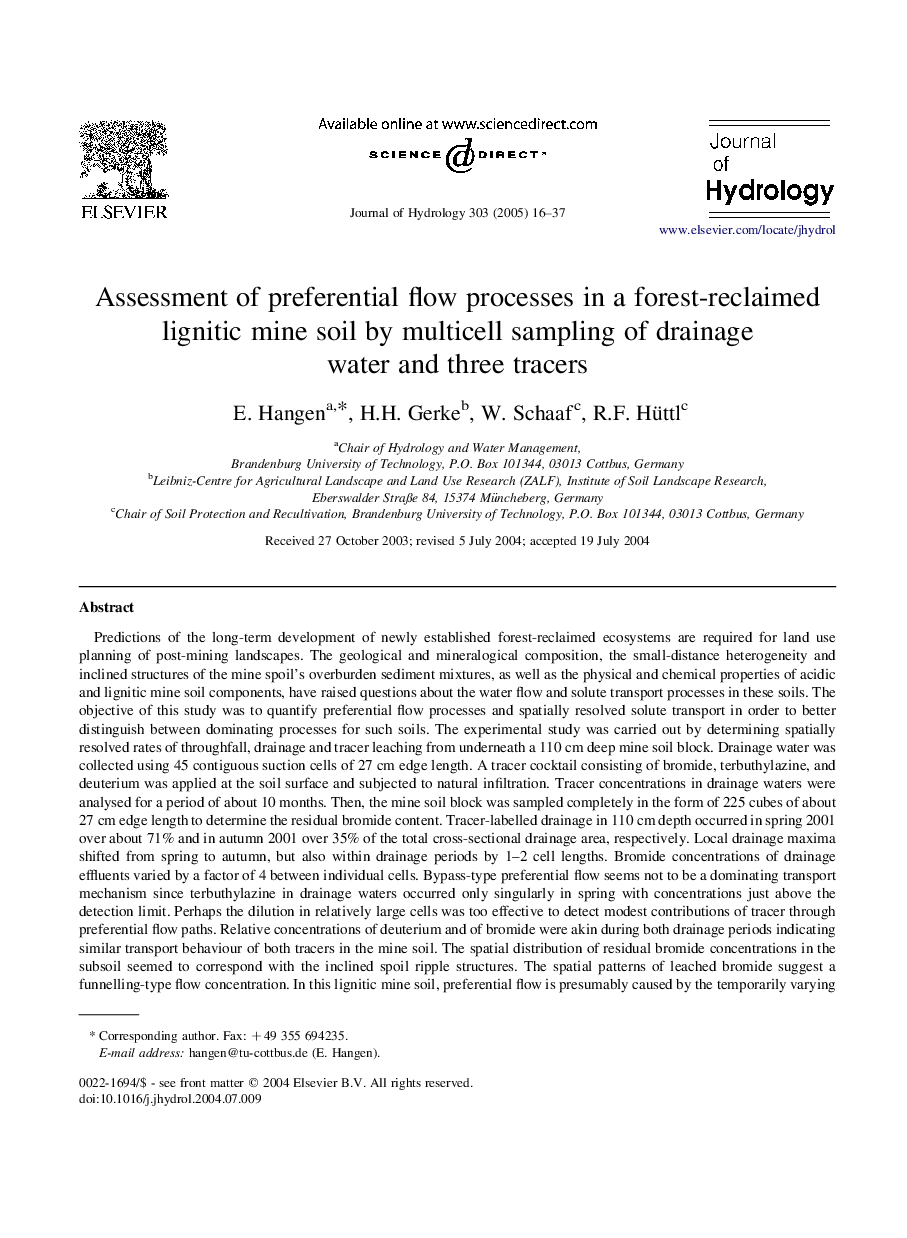| کد مقاله | کد نشریه | سال انتشار | مقاله انگلیسی | نسخه تمام متن |
|---|---|---|---|---|
| 9491378 | 1630188 | 2005 | 22 صفحه PDF | دانلود رایگان |
عنوان انگلیسی مقاله ISI
Assessment of preferential flow processes in a forest-reclaimed lignitic mine soil by multicell sampling of drainage water and three tracers
دانلود مقاله + سفارش ترجمه
دانلود مقاله ISI انگلیسی
رایگان برای ایرانیان
کلمات کلیدی
موضوعات مرتبط
مهندسی و علوم پایه
علوم زمین و سیارات
فرآیندهای سطح زمین
پیش نمایش صفحه اول مقاله

چکیده انگلیسی
Predictions of the long-term development of newly established forest-reclaimed ecosystems are required for land use planning of post-mining landscapes. The geological and mineralogical composition, the small-distance heterogeneity and inclined structures of the mine spoil's overburden sediment mixtures, as well as the physical and chemical properties of acidic and lignitic mine soil components, have raised questions about the water flow and solute transport processes in these soils. The objective of this study was to quantify preferential flow processes and spatially resolved solute transport in order to better distinguish between dominating processes for such soils. The experimental study was carried out by determining spatially resolved rates of throughfall, drainage and tracer leaching from underneath a 110Â cm deep mine soil block. Drainage water was collected using 45 contiguous suction cells of 27Â cm edge length. A tracer cocktail consisting of bromide, terbuthylazine, and deuterium was applied at the soil surface and subjected to natural infiltration. Tracer concentrations in drainage waters were analysed for a period of about 10 months. Then, the mine soil block was sampled completely in the form of 225 cubes of about 27Â cm edge length to determine the residual bromide content. Tracer-labelled drainage in 110Â cm depth occurred in spring 2001 over about 71% and in autumn 2001 over 35% of the total cross-sectional drainage area, respectively. Local drainage maxima shifted from spring to autumn, but also within drainage periods by 1-2 cell lengths. Bromide concentrations of drainage effluents varied by a factor of 4 between individual cells. Bypass-type preferential flow seems not to be a dominating transport mechanism since terbuthylazine in drainage waters occurred only singularly in spring with concentrations just above the detection limit. Perhaps the dilution in relatively large cells was too effective to detect modest contributions of tracer through preferential flow paths. Relative concentrations of deuterium and of bromide were akin during both drainage periods indicating similar transport behaviour of both tracers in the mine soil. The spatial distribution of residual bromide concentrations in the subsoil seemed to correspond with the inclined spoil ripple structures. The spatial patterns of leached bromide suggest a funnelling-type flow concentration. In this lignitic mine soil, preferential flow is presumably caused by the temporarily varying effects of multiple determinants, such as inclined dumping structures, spatial variability of hydraulic properties, water repellence, and the properties of lignitic dust and fragments with some immobile porosity.
ناشر
Database: Elsevier - ScienceDirect (ساینس دایرکت)
Journal: Journal of Hydrology - Volume 303, Issues 1â4, 1 March 2005, Pages 16-37
Journal: Journal of Hydrology - Volume 303, Issues 1â4, 1 March 2005, Pages 16-37
نویسندگان
E. Hangen, H.H. Gerke, W. Schaaf, R.F. Hüttl,